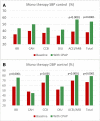Blood pressure control in hypertensive sleep apnoea patients of the European Sleep Apnea Database cohort - effects of positive airway pressure and antihypertensive medication
- PMID: 38035035
- PMCID: PMC10686603
- DOI: 10.1093/ehjopen/oead109
Blood pressure control in hypertensive sleep apnoea patients of the European Sleep Apnea Database cohort - effects of positive airway pressure and antihypertensive medication
Abstract
Aims: We analysed longitudinal blood pressure (BP) data from hypertensive obstructive sleep apnoea (OSA) patients in the European Sleep Apnea Database cohort. The study investigated the interaction between positive airway pressure (PAP)-induced BP change and antihypertensive treatment (AHT).
Methods and results: Hypertensive patients with AHT [monotherapy/dual therapy n = 1283/652, mean age 59.6 ± 10.7/60.6 ± 10.3 years, body mass index (BMI) 34.2 ± 6.5/34.8 ± 7.0 kg/m2, apnoea-hypopnoea index 46 ± 25/46 ± 24 n/h, proportion female 29/26%, respectively] started PAP treatment. Office BP at baseline and 2- to 36-month follow-up were assessed. The interaction between AHT drug classes and PAP on BP was quantified and the influences of age, gender, BMI, co-morbidities, BP at baseline, and study site were evaluated. Following PAP treatment (daily usage, 5.6 ± 1.6/5.7 ± 1.9 h/day), systolic BP was reduced by -3.9 ± 15.5/-2.8 ± 17.7 mmHg in mono/dual AHT and diastolic BP by -3.0 ± 9.8/-2.7 ± 10.8 mmHg, respectively, all P < 0.0001. Systolic and diastolic BP control was improved following PAP treatment (38/35% to 54/46% and 67/67% to 79/74%, mono/dual AHT, respectively). PAP treatment duration predicted a larger BP improvement in the monotherapy group. Intake of renin-angiotensin blockers [angiotensin converting enzyme inhibitor (ACEI)/angiotensin receptor blocker (ARB)] alone or in any AHT combination was associated with better BP control. The AHT-dependent BP improvement was independent of confounders.
Conclusion: In this pan-European OSA patient cohort, BP control improved following initiation of PAP. Longer PAP treatment duration, was associated with a favourable effect on BP. Our study suggests that ACEI/ARB, alone or in combination with other drug classes, provides a particularly strong reduction of BP and better BP control when combined with PAP in OSA.
Keywords: Antihypertensive treatment; ESADA; Hypertension; Obstructive sleep apnoea; Precision medicine.
© The Author(s) 2023. Published by Oxford University Press on behalf of the European Society of Cardiology.
Conflict of interest statement
Conflict of interest: The ESADA study group received unrestricted funding grants from Respironics and Resmed Foundations (2008–11) and an unrestricted collaboration grant from Bayer AG (2018–22). S.S., corresponding author, reports no COI. He has grants from the Swedish Heart and Lung Foundation. J.H. reports no COI related to the content of the manuscript. He has institutional grants from Gothenburg University, Swedish Government Research and Educational grant LUA/ALF and grants from the Swedish Heart and Lung Foundation. Outside of the current manuscript, he has EU grants Horizon 2020, Eureka, and Inter Funding: Sleep Across Waters. He has consulting fees from SomnoMed (advisory input), has received research equipment from Itamar, and owns stock in Cereus Pharma. S.B. reports no COI. F.F. reports no COI. H.H. reports no COI. C.L. reports no COI. O.L. reports no COI. S.M. reports no COI. G.P. reports no COI; he has honoraria for lectures from Merck. A.P. reports no COI. S.S. reports no COI. S.T. reports no COI. D.T. reports no COI; he has payment to his Institution for lectures from Nyxoah. D.Z. reports no COI. L.G. reports no COI related to the content of the manuscript. He has institutional grants from LUA/ALF and the Swedish Heart and Lung Foundation. Outside the current manuscript, he provided lectures for Resmed, Philips, Astra Zeneca, and Lundbeck; and he has ownership in a patent licensed to Desitin GMBH related to sleep apnoea therapy.
Figures



References
-
- Flint AC, Conell C, Ren X, Banki NM, Chan SL, Rao VA, Melles RB, Bhatt DL. Effect of systolic and diastolic blood pressure on cardiovascular outcomes. N Engl J Med 2019;381:243–251. - PubMed
-
- Williams LB, Mancia EG, Spiering W, Agabiti Rosei E, Azizi M, Burnier M, Clement DL, Coca A, de Simone G, Dominiczak A, Kahan T, Mahfoud F, Redon J, Ruilope L, Zanchetti A, Kerins M, Kjeldsen SE, Kreutz R, Laurent S, Lip GYH, McManus R, Narkiewicz K, Ruschitzka F, Schmieder RE, Shlyakhto E, Tsioufis C, Aboyans V, Desormais I; Authors/Task Force Members . 2018 ESC/ESH guidelines for the management of arterial hypertension: the task force for the management of arterial hypertension of the European Society of Cardiology and the European Society of Hypertension: the task force for the management of arterial hypertension of the European Society of Cardiology and the European Society of Hypertension. J Hypertens 2018;36:1953–2041. - PubMed
-
- Visseren FLJ, Mach F, Smulders YM, Carballo D, Koskinas KC, Bäck M, Benetos A, Biffi A, Boavida JM, Capodanno D, Cosyns B, Crawford C, Davos CH, Desormais I, Di Angelantonio E, Franco OH, Halvorsen S, Hobbs FDR, Hollander M, Jankowska EA, Michal M, Sacco S, Sattar N, Tokgozoglu L, Tonstad S, Tsioufis KP, van Dis I, van Gelder IC, Wanner C, Williams B; ESC National Cardiac Societies; ESC Scientific Document Group . 2021 ESC guidelines on cardiovascular disease prevention in clinical practice developed by the task force for cardiovascular disease prevention in clinical practice with representatives of the European Society of Cardiology and 12 medical societies with the special contribution of the European Association of Preventive Cardiology (EAPC). Euro Heart J 2021;42:3227–3337.
-
- Parati G, Lombardi C, Castagna F, Mattaliano P, Filardi PP, Agostoni P. Heart failure and sleep disorders. Nat Rev Cardiol 2016;13:389–403. - PubMed
LinkOut - more resources
Full Text Sources
Research Materials

